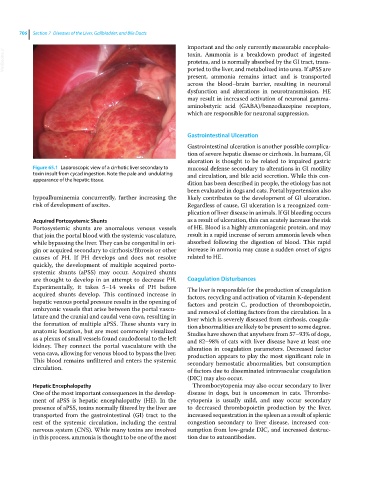Page 738 - Clinical Small Animal Internal Medicine
P. 738
706 Section 7 Diseases of the Liver, Gallbladder, and Bile Ducts
important and the only currently measurable encephalo
VetBooks.ir toxin. Ammonia is a breakdown product of ingested
proteins, and is normally absorbed by the GI tract, trans
ported to the liver, and metabolized into urea. If aPSS are
present, ammonia remains intact and is transported
across the blood–brain barrier, resulting in neuronal
dysfunction and alterations in neurotransmission. HE
may result in increased activation of neuronal gamma‐
aminobutyric acid (GABA)/benzodiazepine receptors,
which are responsible for neuronal suppression.
Gastrointestinal Ulceration
Gastrointestinal ulceration is another possible complica
tion of severe hepatic disease or cirrhosis. In humans, GI
ulceration is thought to be related to impaired gastric
Figure 65.1 Laparoscopic view of a cirrhotic liver secondary to mucosal defense secondary to alterations in GI motility
toxin insult from cycad ingestion. Note the pale and undulating and circulation, and bile acid secretion. While this con
appearance of the hepatic tissue.
dition has been described in people, the etiology has not
been evaluated in dogs and cats. Portal hypertension also
hypoalbuminemia concurrently, further increasing the likely contributes to the development of GI ulceration.
risk of development of ascites. Regardless of cause, GI ulceration is a recognized com
plication of liver disease in animals. If GI bleeding occurs
Acquired Portosystemic Shunts as a result of ulceration, this can acutely increase the risk
Portosystemic shunts are anomalous venous vessels of HE. Blood is a highly ammoniagenic protein, and may
that join the portal blood with the systemic vasculature, result in a rapid increase of serum ammonia levels when
while bypassing the liver. They can be congenital in ori absorbed following the digestion of blood. This rapid
gin or acquired secondary to cirrhosis/fibrosis or other increase in ammonia may cause a sudden onset of signs
causes of PH. If PH develops and does not resolve related to HE.
quickly, the development of multiple acquired porto
systemic shunts (aPSS) may occur. Acquired shunts
are thought to develop in an attempt to decrease PH. Coagulation Disturbances
Experimentally, it takes 5–14 weeks of PH before The liver is responsible for the production of coagulation
acquired shunts develop. This continued increase in factors, recycling and activation of vitamin K‐dependent
hepatic venous portal pressure results in the opening of factors and protein C, production of thrombopoietin,
embryonic vessels that arise between the portal vascu and removal of clotting factors from the circulation. In a
lature and the cranial and caudal vena cava, resulting in liver which is severely diseased from cirrhosis, coagula
the formation of multiple aPSS. These shunts vary in tion abnormalities are likely to be present to some degree.
anatomic location, but are most commonly visualized Studies have shown that anywhere from 57–93% of dogs,
as a plexus of small vessels found caudodorsal to the left and 82–98% of cats with liver disease have at least one
kidney. They connect the portal vasculature with the alteration in coagulation parameters. Decreased factor
vena cava, allowing for venous blood to bypass the liver. production appears to play the most significant role in
This blood remains unfiltered and enters the systemic secondary hemostatic abnormalities, but consumption
circulation. of factors due to disseminated intravascular coagulation
(DIC) may also occur.
Hepatic Encephalopathy Thrombocytopenia may also occur secondary to liver
One of the most important consequences in the develop disease in dogs, but is uncommon in cats. Thrombo
ment of aPSS is hepatic encephalopathy (HE). In the cytopenia is usually mild, and may occur secondary
presence of aPSS, toxins normally filtered by the liver are to decreased thrombopoietin production by the liver,
transported from the gastrointestinal (GI) tract to the increased sequestration in the spleen as a result of splenic
rest of the systemic circulation, including the central congestion secondary to liver disease, increased con
nervous system (CNS). While many toxins are involved sumption from low‐grade DIC, and increased destruc
in this process, ammonia is thought to be one of the most tion due to autoantibodies.

